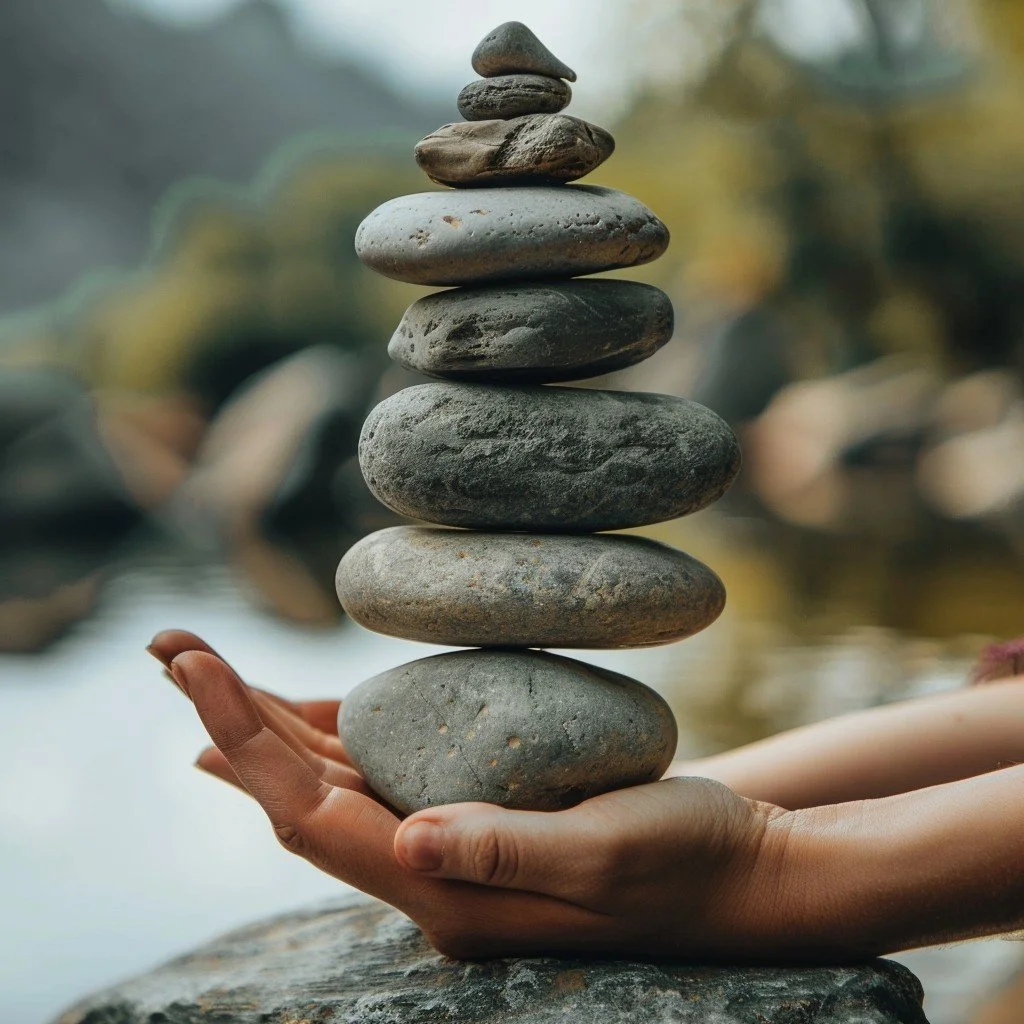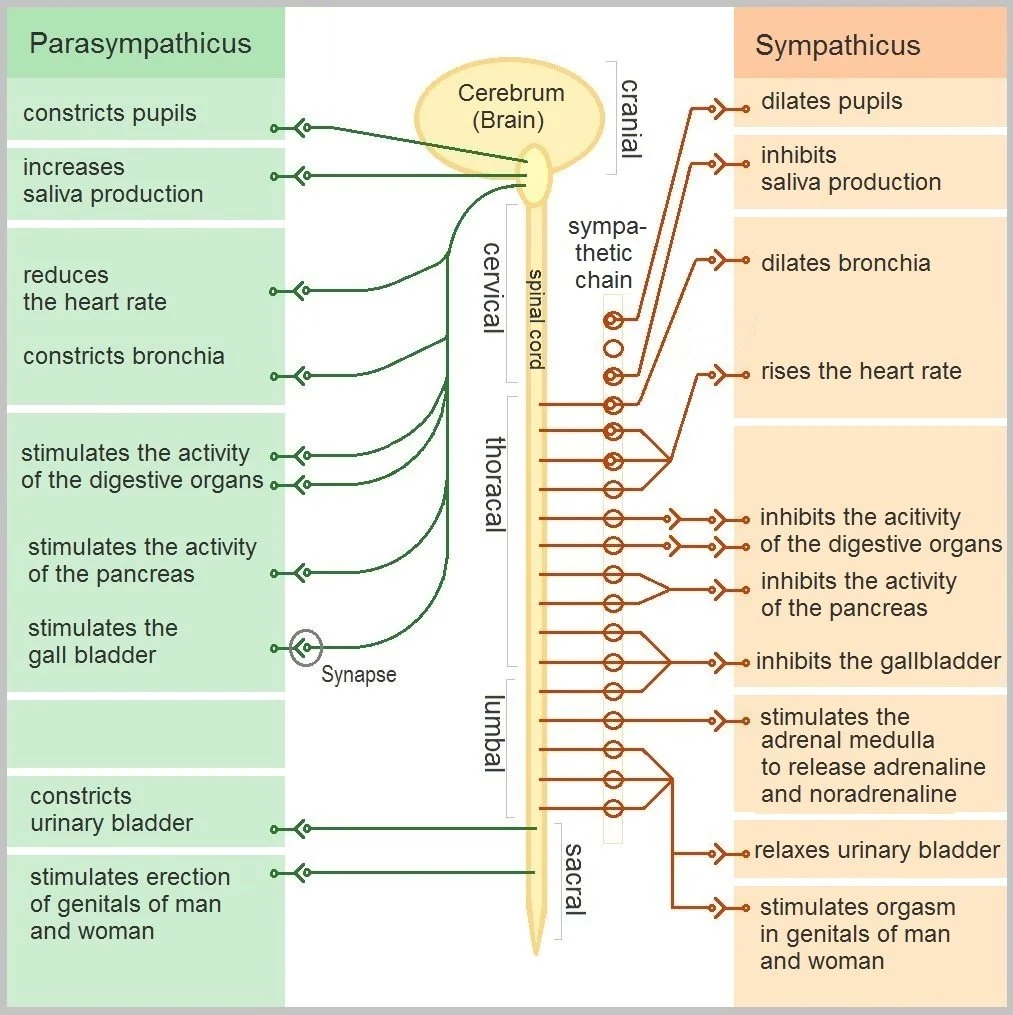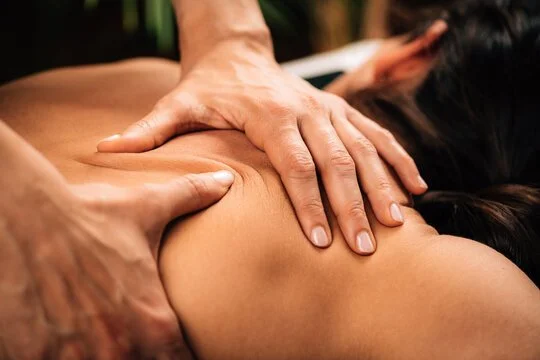Why Safety is Important for your Nervous System and How Massage Can Help
If you’re a returning reader to this blog then you’ve undoubtedly heard me sing the praises of generating safety in the nervous system. In fact, I think it’s one of the most scientifically sound and beneficial attributes of receiving massage. It can offer us a lot in terms of alleviating our experience of pain and stress. Yes, even more so than loosening muscles or busting up knots. While the past few decades of scientific inquiry into the world of manual therapies have come up a bit…scattered- one of the undeniable findings is that this practice is a wonderful tool to help us regulate our nervous system. This phrase, ‘regulating the nervous system’ has become a bit of a trend lately with pop psychology and the mountains of books on healing trauma and dealing with anxiety. What does it mean though and why is there so much buzz about it?
In order to answer these questions, it’s going to require us to understand some basic principles about where this regulation…or dysregulation is taking place. From there, we can gain a better understanding of how this process is affecting our minds, bodies, and experiences of pain. So let’s get started shall we?
Now Introducing: The Autonomic Nervous System
While the body systems involved in nervous system regulation are far too numerous to accurately represent in a small blog like this, the one that is of most relevance is what is known as the Autonomic Nervous System. This is a portion of our peripheral nervous system (every part of your nervous system that isn’t your brain or spinal cord) which is responsible for controlling unconscious bodily functions such as breathing, heart rate, and digestion. It’s whole goal in our survival is twofold; on one hand, it’s responsible for preparing our body to respond to danger, and on the other, it helps us wind down and relax once the danger has passed. It does this through three distinct divisions that work in a push/pull kind of dynamic. These divisions are the, sympathetic, parasympathetic, and enteric.
The sympathetic response is what fires up when we’re finding ourselves in a moment of stress. This is what’s conventionally referred to as the fight, flight, or freeze response. When the sympathetic response takes hold, the parasympathetic takes a step back. The Parasympathetic response is our rest and digest response - which happens once the danger is clear and we’re feeling comfortable enough to allocate our body’s energy to internal processes. The Enteric division isn’t really important for this discussion but it relates to how the body digests food. Maybe we’ll cover this in another article.
This push/pull of the two main divisions we covered above affects a lot. There are connections to most if not all of the body’s organs, with their function changing somewhat dramatically depending on what mode we’re in (sympathetic or parasympathetic). Some of these systems include:
- Circulatory System
- Immune System
- Respiratory System
- Digestive System
- Liver and Pancreas
- Reproductive System
- Urinary System
Not only does it affect these subconscious elements of our body, but it also plays a hand in how our mind is operating at any given time. It can affect our ability to socialize, feel comfortable or anxious, be either resourced or overwhelmed, and create or release tension in the body (which is more a mental event than we generally give credit for).
Now, I wouldn’t blame you if after reading that, you made a commitment to never again be in a sympathetic response. But wait! It’s important to note before we move forward that both of these aspects of our embodiment are important and adaptive. If we didn’t have the fight/flight response, we likely would have been eaten by tigers in our distant past. The goal with this article is to not demonize our own biology but rather understand it so that we can equip ourselves with the knowledge to embody it more fully. The sympathetic response has it’s own wisdom and if we’re able to recognize it when it’s present, we’ll be able to tap that wisdom and ultimately let it go when it needs to be dropped.
Before we move on to talking about regulation, I think it’s important to spend a little more time discussing what happens when we’re in either the sympathetic or parasympathetic response. That way we can begin to see it within our own experience and begin tracking our internal rhythms.
The Effects of the Sympathetic/Parasympathetic States
If the last section of this article is dedicated to the ‘what’ of this conversation, this next part will be dedicated to the ‘where’ and the ‘how’. It’s important to understand how each of these distinct states affect our bodily systems so that we can begin to detect more readily when we’re activated or at rest. The quicker we can connect to where we are at any given moment, the more insight we’ll have into what we’re needing in that situation. Understanding this more deeply can also help us see how massage and other practices like it can impact our lives and bring us benefit.
Sympathetic State Effects
1. Increased Heart Rate
One of the main features of a sympathetic response is an escalated heart rate. This is due to the bodies increased demand for oxygen required to power muscles in the situation of a chase or some other form of conflict. The more oxygen available, the more juice we have to perform physical actions. This is great for exercising, playing a sport, or doing physical labor. It’s not so great when we’re trying to unwind at the end of the day or focus on something that requires our sustained attention. When it becomes chronic it can result in increased blood pressure which leads to a host of problems.
2. Slowed Digestive Tract
Digestion is a luxury afforded to those who will live to see another day. In times of sympathetic activation, the energy that’s generally allocated to the digestive process is pulled back and invested in other systems to help avoid an untimely death. This in turn causes indigestion, nausea, bloating, and other nutrient intake deficiencies. I’m sure we can all remember a time when we have to give a presentation and feel butterflies in our stomach, we can thank our sympathetic response for that. When we’re chronically in this state, it can create lasting gastrointestinal issues and even eating disorders.
3. Lowered Pain Threshold
When the body is in a state of stress, it’s primed to detect danger in our external AND internal environments. As we’ve discussed in other articles, pain has less to do with reporting on harm that’s happened in the body, but more to do with the POTENTIAL for harm. This means that we can feel pain when there isn’t actual damage done to the tissues. When we’re on red alert from sympathetic arousal, the body’s pain threshold drops considerably so that we can respond as quick as possible to any potential damage from whatever is causing us stress. This is why it’s vitally important to get a handle on our stress levels if we struggle with chronic pain - the more stressed we are, the more pain we feel.
4. Increased Stress Hormones
When our sympathetic system has taken over, our body gets flooded with stress hormones that help motivate action. The two main culprits in this are Cortisol and Adrenaline. Each of these are used to help motivate sudden action and attentiveness. Again, this can be great in certain situations but bad when they’re present over long periods of time. They can tax the adrenal system, make us agitated or anxious, affect our sleep, and eventually lead us to burnout. All of this gets expressed in our bodies, through tension and diminished energy reserves.
5. Other Examples
While the ones above are most pertinent to our broader conversation, the entire body goes through changes when we’re sympathetically activated. Our pupils dilate to let more light in, our immune system dampens (meaning we’re more likely to get sick), we sweat more, and we have troubles with urination. These are the most directly observed effects but there are more.
Parasympathetic State Effects
On the other side of the ANS see-saw is our rest, digest, and socialize state. This is at the heart of what it means to feel a sense of somatic safety. It offers us a host of regulatory effects which are absolutely required to be of sound mind and body. Let’s take a look:
1. Decreased Heart Rate and Blood Pressure
Since our bodies are generally at rest in the parasympathetic state, there’s not much use for having excessive amounts of oxygen in the peripheral tissues. Because of this, our heart rate slows down and as a result, the pressure in our circulatory system lowers. This takes a burden off from the heart and reduces our risk of potentially life threatening cardiac disease.
2. Digestive Track Turns On
When there is no perceived threat, the body turns it’s focus on to moving food through the system, processing nutrients, and expelling the resulting waste. While we can certainly eat in both states, our body will have a lot more resources available to effectively process the food that we take in when we’re relaxed. This means that we’re able to extract more nutrients from our food and then turn it into fuel to regenerate our cells more effectively. It also promotes healthy bowel movements and regular urination which prevent gastrointestinal and urinary issues.
3. Increased Immune Response
If you’ve ever been sick with the common cold, which let’s face it: we all have. You may have noticed that you tend to get more sick as the day goes on, ending with sleepless nights of intense symptoms. This is because our nervous system naturally moves through phases throughout the day, with the sympathetic state more prominent during waking hours and the parasympathetic taking over in the evening. When our body is at rest, it gives our immune system more resources to combat infections and other viruses. This is why it’s generally recommended to take lots of rest when we’re under the weather.
4. Social Centers Come Online
When we’re feeling safe within ourselves, we’re primed to connect more fully with those we’re interacting with. This is due to a couple of factors, some psychological, and some physiological. On one hand, feeling calm allows us to trust others more easily. Since our attention isn’t focused on scanning for potential threats, we have more resources available to show curiosity for other people’s experience. It also frees us up to be more spontaneous leading to more opportunities for humor. Physiologically speaking there are some really interesting things happening when we’re feeling safe. First, our range of hearing literally changes, emphasizing the range of frequencies that the human voice is found within - rather than focusing on lower more threatening tones. This allows us to tune into more subtlety and nuanced deliveries of speech.
Beyond that, our facial muscles are more relaxed which allows us to convey a wider range of emotions - especially around the ridge of the eyebrows. This not only allows us to be more expressive, it also helps us understand other people as our bodies subconsciously mirror our speaking partners mannerisms to better understand their messages. (No really, it’s called somatic empathy and it’s really cool).
Applying this understanding to our daily interactions, this provides us a lot of context for people who are just downright…rude. Chances are, there’s an element of chronic sympathetic arousal that has dulled their ability to socialize over the years.
5. Reduces Tension in the Body
The most obvious facet of being relaxed is…well being relaxed. When we’re in a parasympathetic response state, our bodies are able to find an effortless sense of ease which can help us let go of the stresses of the day. This is obviously great for many reasons but one of the more inspiring ones that I find is that it helps us move more gracefully. There’s a beauty and a deep meaningfulness that comes from smooth and intentional movement. The more we can perform actions from this place of relaxation, the more conditioned our body becomes at being relaxed. This carries out beyond the confines of our home and seeps into our interactions with the world at large.
Bringing It All Together and Where Massage Fits In
So now that we’ve taken inventory of how this ancient yet advanced system within our body is changing our experience at any given moment. What do we do with this information? Well, I think it would be totally justifiable to pursue maximizing our parasympathetic activation while minimizing our sympathetic response. I’d argue that many of us would have great benefit in taking this course of action - especially in these times of great societal unrest and chronic activation. We’re constantly bombarded by terrible news story after terrible news story. In fact, we’re more connected to the harm being caused in the world than ever before, and this DEFINITELY has an effect on our levels of activation. Even if we weren’t living with unparalleled times, it’s downright stressful to be alive in a human body. We age, we get sick, we lose and gain money, and we watch those we care about pass away - there’s a lot to manage. This is why I advocate not for a dismissal of our sympathetic response but an integration of it.
Integrating means learning how to dip in and out of sympathetic states with more skill and intention. It also means learning how to cultivate a more readily available parasympathetic state. This is a two pronged approach that respects and collaborates with our hardwiring. On one hand, we need to learn how to express this sympathetic energy so that it doesn’t stagnate in the body. This means incorporating more movement in our kinesthetic diets; weight lifting, running, climbing, dancing, learning something new that has a modicum of challenge. It’s good to learn how to be strained without it capsizing us. This also gives us an opportunity to activate and deactivate our systems, which is an important skill to learn. With the amount of stressors bombarding us all the time, it’s very easy for our sympathetic response to become habitual and “stuck”. AKA, we forget how to bring ourselves back from the edge.
This is why at the same time, we need to actively PRACTICE relaxation. It’s not enough to collapse on the couch at the end of a long day and zombie out to the television. While that’s not bad in and of itself, oftentimes what we take in through the screen is activating in it’s own right. Action movies, violence on the screen, a constant barrage of news all bring us to subtle states of activation. What I’m advocating for instead is creating an intentional time to bring your entire system into a state of ease. There are numerous ways that we can do this with varying degrees of skill required. This is where massage can be an EXCELLENT addition to your life. It’s a great doorway to propel yourself into deeper realms of relaxation that you didn’t know were possible. There’s an added benefit of it containing a social element as well, as learning how to relax into human connection provides a different set of variables that can be tremendously helpful. Best of all, it’s very accessible and requires no real barrier for entry.
The more we can intentionally access our parasympathetic state, the easier our time of navigating pain will be. This is why generating safety in the nervous system is paramount to our healing process. This doubles so when we are experiencing pain; can we simultaneously hurt and still find relaxation in other parts of our body? It’s a profound question and it’s one that’s explorable within our unique circumstances. It serves as a tremendous resource that gives us an opportunity to carve out a space within our stressful or pained experience so that we can connect to new insights into our lives.
How Else Can We Generate Safety?
Alright so let’s be honest with each other - as great as massage is, it’s often out of people’s budgets to have consistently. While I think it does offer a unique and effective way of cultivating more ease in the nervous system, it’s not going to be the only tool in your disposal if you want to really work this perspective into your life. There are some other low-cost options that I totally encourage my clients to explore. Best yet, the more you experiment with different modalities…the better your massage experience will be. This is because over time we become more familiar with deep relaxation ( the parasympathetic response) and it becomes more readily accessible to us. So much of what makes massage a “practice” is in learning how to let go of the rest of the day and truly allow yourself to be held in a therapeutic container.
If someone is new to the therapeutic relationship or massage in general, it can actually prove to be quite challenging to settle into the experience. This can express itself through body insecurity, a lack of trust in the practitioner’s intentions, feeling like we have to “do something” during the session. While none of this should cause us to feel shame, it takes away from our ability to truly let go enough to enter into the deeper states that are available through massage. So it can be a tremendous help to the massage session if we have some prior experience with feeling safe in our nervous system. Again, it’s not a deal breaker and it’s something that we can build through massage, but there are also other things we can do to build it.
1. Yoga Nidra
This is one of the easiest and most accessible ways to begin accessing deep relaxation in our daily lives. Yoga Nidra is essentially, sleep yoga. This is a guided practice where we listen to a recording of someone as we lie down in a comfortable position. The instructor will then take you on a guided journey into your body, inviting you to intentionally relax each part of yourself in a particular sequence. The result is a very deep and profound state that lasts as long as long as you want it to. You can find free sessions on YouTube of any length, from 20 minutes to 2 hours. (This is also great for insomnia)
2. Tai Chi
This is my preferred practice for learning how to intentionally relax my body. It involves very gentle yet precise movements in a patterned sequence. The goal is to make these complex movements with as little effort as possible. I don’t know the science behind it but the sense I get is that it’s training our motor system to move more efficiently and with less energy. The result is an overall reduction in tension throughout the body and a heightened sense of awareness about our levels of activation. People who subscribe to the Traditional Chinese view of things will also say that the flow of qi is enhanced - though I don’t know much about that.
3. Self Care Days
This is probably the most important and cost effective approach we can take to generating safety. Literally set aside a day to do nothing. Take naps, take a nice hot bath, light some candles and journal, put on a yoga nidra, go for a walk in nature. Do whatever it is that you LOVE to do. Having fun, being creative, letting yourself have unstructured time to just exist can do wonders for your nervous system regulation. Just make sure that you put your phone away so the temptation to doom scroll doesn’t soak up your time.
4. Walking in Nature
As mentioned above, nature is a wonderful regulating partner. Science has shown time and time again that spending time outside amongst the trees and the creeks does wonders for helping us feel a sense of grounded peace. Our regulation is dependent on our surroundings, meaning that we tend to become activated because we’re being met with something stressful. A big part of our inability to be resilient is because we’re separated from the natural surroundings that we’ve evolved with over millions of years. Reconnecting with nature reminds us about our inherent interdependence with all things…and that is a hell of a resource.
Wrapping Up
So that’s what you need to know about safety in the nervous system - where it is, how it works, and what we can do to cultivate it. There are a lot of other angles to look at this topic from but I wanted to make this accessible to you for right now. Massage is a great way to begin your journey into this work, the effect is immediate and undeniable. It’s also not the only way! While I would love for everyone who reads this to book a session, I’d much rather people do what’s right for them and their current life situation. Knowledge truly is power, and the more we learn about our bodies and the intricate wiring that creates our daily experience, the more agency we have in responding to the demands of our lives. If you want to continue learning about this material, I highly recommend the work of Dr. Stephen Porges and his Polyvagal Theory. I’d also recommend Robert Sapolsky’s ‘Why Don’t Zebras Get Ulcers’.
If you want to book a session, use the link up top and I’d be happy to meet you in the office. If pricing is an issue, please feel free to reach out and I’d be open to working on a sliding scale that meets your budget. Take care out there!






